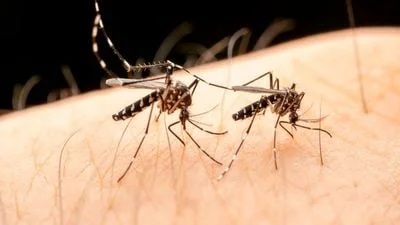Researchers have made significant strides in understanding mosquito mating behavior, a discovery that could play a crucial role in malaria control. While the high-pitched buzz of a mosquito is often just an annoyance for humans, it holds a very different meaning for male mosquitoes—it’s a mating cue. The sound of a female mosquito’s wingbeats helps males find their mates, as they rely heavily on auditory signals to locate females.
The study, led by scientists from the University of Washington and published in Current Biology, reveals that male mosquitoes, despite their poor vision, use the sound of female wingbeats to activate their visual systems. This helps them navigate through crowded swarms and accurately find potential mates. Since many mosquito species, particularly those in the Anopheles genus, gather in large swarms at sunset with only a few females present, males must use their senses to avoid collisions and successfully mate.
“We’ve uncovered an extraordinary connection between the auditory and visual systems of male mosquitoes,” said Saumya Gupta, the study’s lead author and postdoctoral researcher. “When male mosquitoes hear the specific wingbeat frequency of females, it triggers their visual systems and guides them to potential mates.”
The research team simulated swarm conditions in a controlled environment to observe mosquito behavior. They discovered that males are strongly attracted to objects when they hear sounds that mimic female wingbeats. This insight opens the door to innovative mosquito control strategies, such as specialized traps designed to exploit male mosquitoes’ attraction to these sounds.
“Male mosquitoes are so drawn to the sound of female wingbeats that they steer toward what they believe to be the source, whether it’s an actual female or a potential mosquito trap,” said Jeffrey Riffell, the study’s senior author and a biology professor at UW.
This groundbreaking research involved collaboration with the Health Sciences Research Institute in Burkina Faso, Wageningen University in the Netherlands, and the University of Montpellier in France. To test their hypothesis, the team built a mosquito flight simulator that mimicked the chaotic conditions of a real swarm. Their experiments revealed that when male Anopheles coluzzii mosquitoes heard a tone resembling female wingbeats (450 hertz), they were more likely to move toward an object in their field of vision. However, they showed no such response to a higher-pitched tone that mimicked male wingbeats (700 hertz).
Interestingly, the mosquito’s response also depended on how close the object was. If the object appeared more than three body lengths away, males did not steer toward it, even if they heard female-like flight sounds.
“Mosquitoes have much lower visual resolution compared to humans,” Riffell explained. “They mostly rely on vision to avoid obstacles or control their position, but when they hear female flight tones, it changes their behavior dramatically.”
The study also found that male mosquitoes adjust their wingbeat patterns to avoid collisions within swarms, even when they don’t hear female flight tones. This suggests that males use visual cues to avoid other males but rely on sound for mate detection.
These findings could pave the way for a new generation of mosquito control measures. Current methods, such as insecticides, are becoming less effective due to increasing resistance.
By focusing on how mosquitoes combine auditory and visual information to find mates, researchers hope to develop more targeted approaches, such as lures or traps specifically designed to attract Anopheles mosquitoes, which are the primary carriers of malaria.
“Controlling mosquito swarms is a key strategy in reducing biting and the spread of malaria,” said Riffell. “With resistance to insecticides on the rise, we urgently need innovative solutions, and this research gives us a promising direction.























